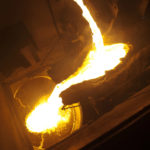Carbon content variations have a pronounced effect on steel; apart from the obvious chemical changes that occur as carbon content changes, there are also important changes to the mechanical properties of a steel as well. Carbon content affects the hardness, strength, crack resistance, and formability of a steel, to name a few characteristics. Decreases in carbon content are commonly caused by a phenomenon known as decarburization. It is critical to understand the amount of decarburization a steel undergoes as it is exposed to different types of processing and fabrication.
What is Decarburization?
Decarburization is the reduction of carbon content in steel. It typically occurs when a steel is heated above the lower limit of its recrystallization temperature, usually around 700 degrees Celsius. When steel is elevated to this temperature and exposed to gases such as hydrogen and oxygen, the steel’s carbon bonds with those gases and leaves the steel with a reduced amount of carbon. Since the gases are only in contact with the surface of a steel, decarburization generally occurs most heavily on the outermost layers of a steel. The carbon reduction results in a loss of tensile strength, fatigue strength, and hardness.
How to Prevent Decarburization
Decarburization can be detrimental, but it can readily be controlled or removed. One way to prevent decarburization from happening is to prevent it from reaching its recrystallization temperature. This prevents the ability of the carbon to migrate from the surface of the steel to the ambient gases. Because steel must sometimes be heated to this temperature, another method for decarburization prevention is to flood the surroundings of the steel with gases that do not react with the carbon. Popular gases for this method of prevention include argon and nitrogen, although further research should be done to determine which gas is best to use for a given application.
How to Remove Decarburization
If decarburization is unable to be prevented, it can still be removed through several methods. One way to remove decarburization is to remove the decarburized material entirely. This can be done through milling, grinding, or a variety of other machining processes. Another popular process for getting rid of decarburization is to restore the carbon that was lost back to the steel substrate. This can be done after a steel has been decarburized by heating it back up to its recrystallization temperature and flooding the area around it with hydrocarbons. Care needs to be taken when doing this to ensure that the right amount of carbon is returned to the surface of the steel.
Read more: What is Decarburization?






